Discover Fetsund Timber Booms and the Øyeren River Delta
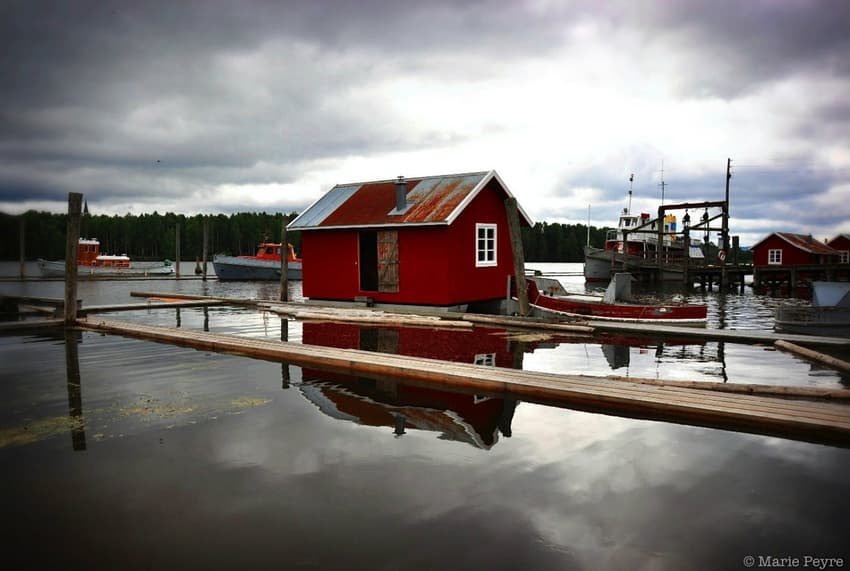
Less than half an hour from Oslo centre, the Fetsund Timber Booms Museum and the Øyeren River Delta combine fascinating history and unique nature. A fun and educational day trip, says our travel editor Marie Peyre.
The Fetsund Timber Booms
As many as 100,000 logs used to pass through the Fetsund Timber Booms (Fetsund Lenser) every day. That's a whopping 14 million logs in the course of one season, which typically lasted from May to October. The amount of timber transported would today equal a convoy of fully loaded trucks stretching bumper to bumper from Halden in southern Norway to Tromsø in the far north. Timber was the oil of the day.

Photo: Industrimuseum (1915)
The timber came from densely forested areas in the Eastern and Gudbrand Valleys, floating down the River Glomma, Norway's longest watercourse, to Fetsund. Upon reaching the timber booms the logs would be directed through a floating canal and sorted out - some taken out of the water to be sent to local sawmills, the rest tied together (500 logs per bundle) before making their way with a tug boat over Lake Øyeren. The bulk of the timber ended up in Fredrikstad (known as 'plank city'), over 100 kilometres downstream, from where it was shipped out to Britain and the continent.
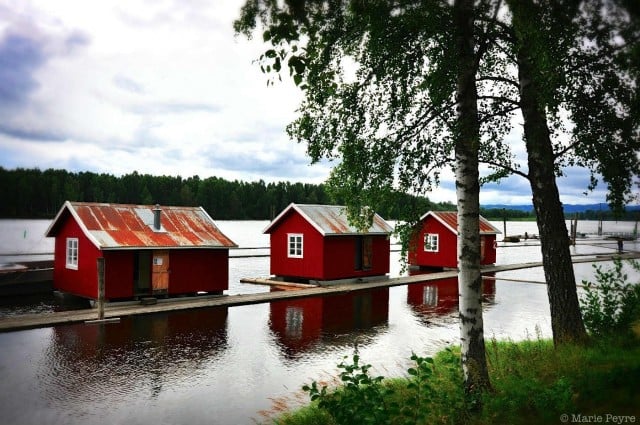
Photo: Marie Peye
Fetsund Timber Booms were built in 1861, and the timber floating and sorting plant, one of Norway's largest, was in operation until as late as 1985. Needless to say the timber floating industry was an important business for the whole region. The plant itself employed 300 men, but also provided a livelihood for many others working in related industries.
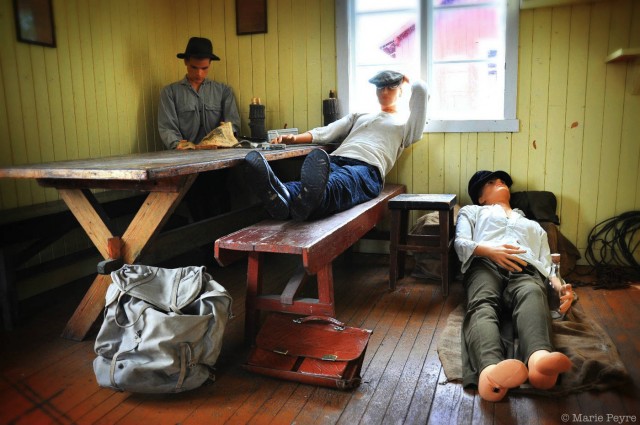
Photo: Marie Peyre
The Timber Boom Museum was established in Fetsund in 1989, and now attracts some 60,000 visitors annually. The museum, a Norwegian national heritage site, is the only one of its kind in the world, and is a truly unique place to learn about the timber floating industry.
Exhibits include rafting boats, machinery, workers' dwellings, workshops, various tools and a smithy, as well as the timber-sorting facility on the water. Visitors can also 'walk on the water', just like workers at the timber booms used to do, by following a network of floating plank paths around the museum. A popular activity with many - not least children.
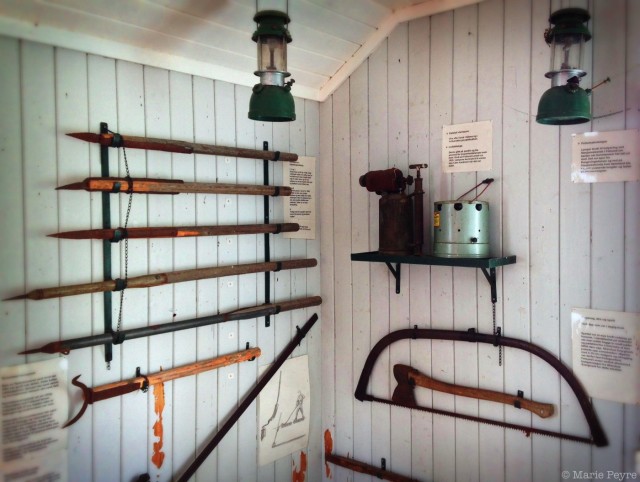
Photo: Marie Peyre
Work at the timber booms had to stop when the river was covered in ice (from late autumn to spring), and the site was only in full activity half of the year. So it is today. The museum is open from May to mid-September, although several members of staff work year round on maintenance - just like was customary then. All repairs are still carried out using old tools and methods, thus ensuring that skills that would otherwise have died are preserved for future generations.
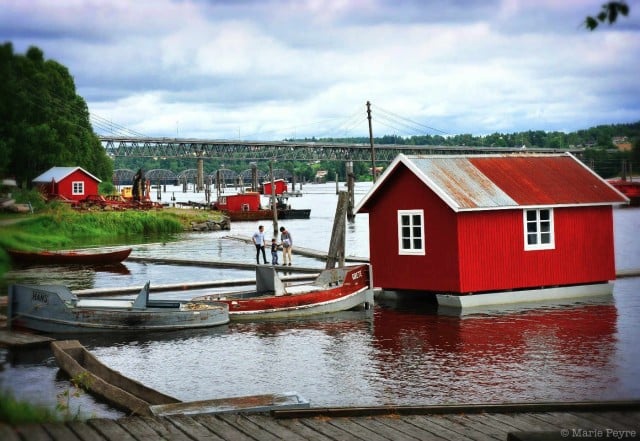
Photo: Marie Peyre
The Øyeren River Delta
Less than a kilometre downstream from the timber booms lies the Øyeren River Delta, Northern Europe's largest inland delta. For thousands of years, sand and gravel have formed islands, narrow canals, lush islets and coves on this very special spot where the Glomma flows into Lake Øyeren.
This ever-changing landscape, constantly reshaped by the water flowing through it, is a unique wetland area boasting a record number of freshwater fish species (25 in total), as well as many amphibians, reptiles and insects. Some mammals also live here - beavers for example have made their home in the delta.
And of course, there are the birds. Nordre Øyeren Nature Reserve is a Ramsar site and a very important resting and feeding area for water birds such as ducks, geese, waders and thousands of whooper swans in particular, who stop here during their migration in autumn and spring. More than 100 different bird species can be seen in the delta then, although only about 35 species breed here, mostly because of the water level fluctuation, which makes ground-nesting difficult in such a flat area.
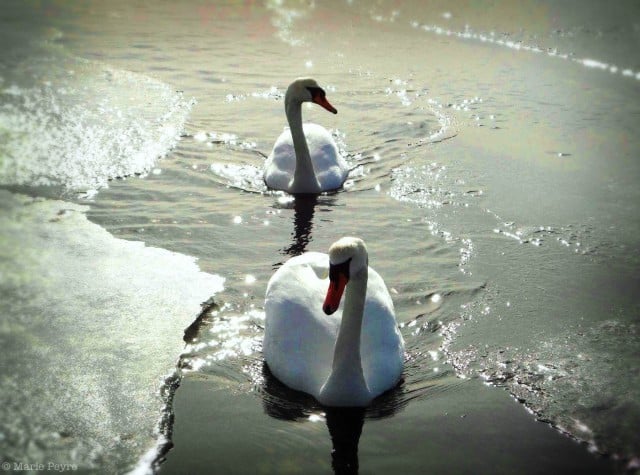
Photo: Marie Peyre
The best way to explore the Nordre Øyeren Nature Reserve is from the water. Paddling here makes for a great experience, whether by canoe or kayak, as you will get really close to the wildlife, gliding silently down narrow channels and river arms. You never know what you might see next: an osprey fishing? A moose and her calf going for a swim? Each trip in the delta is different.
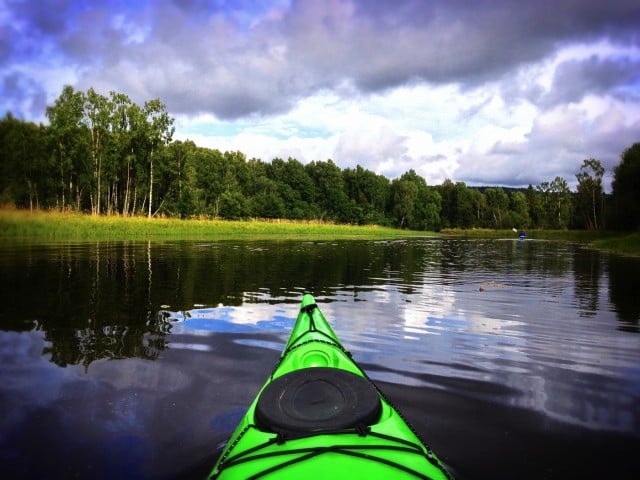
Photo: Marie Peyre
If paddling sounds too energetic, MS Øyeren organises trips to the delta every Sunday from May to September (Saturdays too in July). Departure from Fetsund Timber Booms Museum at 13.30. The trip lasts 90 minutes.
Celebrating 20 years in 2017, the Nordre Øyeren Wetland Visitor Centre (part of the museum) gives an insight into the fauna and flora of the Øyeren Delta, and is well worth a visit too, particularly if you are travelling with children.
Plan your trip
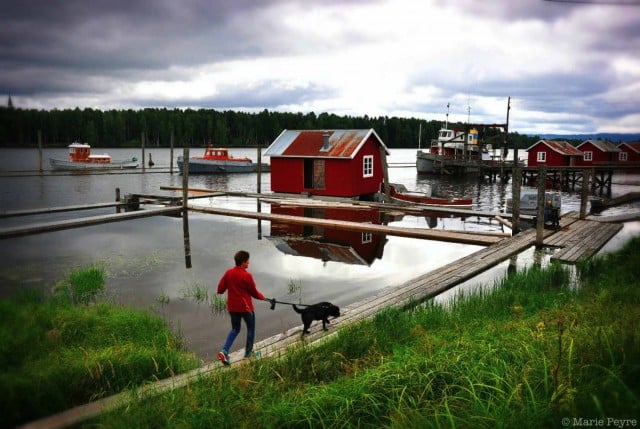
Photo: Marie Peyre
Getting there: By train Kongsvingerbanen to Fetsund station (20 minutes from Oslo), or E6 Oslo/Gardermoen to Lillestrøm, then Fv22.
Stay: Quality Hotel Olavsgaard in nearby Skjetten is a very convenient place to stay if you are coming by car (it's just off the E6). The hotel boasts an impressive art collection, with hundreds of works by contemporary Norwegian artists, most of them specially commissioned.
Eat: The cafe at the museum has a lovely waterside terrace. They serve fish cakes, waffles, cured meats and occasionally moose burgers.
Visiting the museum: Fetsund Timber Booms Museum is open from 1 May to mid-September.
Kayak rental: Fetsund kano- og kajakkutleie have two kayaks and several canoes for rent. For booking contact Peter B. Straumann by email.
More information: Visit Akershus
Comments
See Also
The Fetsund Timber Booms
As many as 100,000 logs used to pass through the Fetsund Timber Booms (Fetsund Lenser) every day. That's a whopping 14 million logs in the course of one season, which typically lasted from May to October. The amount of timber transported would today equal a convoy of fully loaded trucks stretching bumper to bumper from Halden in southern Norway to Tromsø in the far north. Timber was the oil of the day.

Photo: Industrimuseum (1915)
The timber came from densely forested areas in the Eastern and Gudbrand Valleys, floating down the River Glomma, Norway's longest watercourse, to Fetsund. Upon reaching the timber booms the logs would be directed through a floating canal and sorted out - some taken out of the water to be sent to local sawmills, the rest tied together (500 logs per bundle) before making their way with a tug boat over Lake Øyeren. The bulk of the timber ended up in Fredrikstad (known as 'plank city'), over 100 kilometres downstream, from where it was shipped out to Britain and the continent.

Photo: Marie Peye
Fetsund Timber Booms were built in 1861, and the timber floating and sorting plant, one of Norway's largest, was in operation until as late as 1985. Needless to say the timber floating industry was an important business for the whole region. The plant itself employed 300 men, but also provided a livelihood for many others working in related industries.

Photo: Marie Peyre
The Timber Boom Museum was established in Fetsund in 1989, and now attracts some 60,000 visitors annually. The museum, a Norwegian national heritage site, is the only one of its kind in the world, and is a truly unique place to learn about the timber floating industry.
Exhibits include rafting boats, machinery, workers' dwellings, workshops, various tools and a smithy, as well as the timber-sorting facility on the water. Visitors can also 'walk on the water', just like workers at the timber booms used to do, by following a network of floating plank paths around the museum. A popular activity with many - not least children.

Photo: Marie Peyre
Work at the timber booms had to stop when the river was covered in ice (from late autumn to spring), and the site was only in full activity half of the year. So it is today. The museum is open from May to mid-September, although several members of staff work year round on maintenance - just like was customary then. All repairs are still carried out using old tools and methods, thus ensuring that skills that would otherwise have died are preserved for future generations.

Photo: Marie Peyre
The Øyeren River Delta
Less than a kilometre downstream from the timber booms lies the Øyeren River Delta, Northern Europe's largest inland delta. For thousands of years, sand and gravel have formed islands, narrow canals, lush islets and coves on this very special spot where the Glomma flows into Lake Øyeren.
This ever-changing landscape, constantly reshaped by the water flowing through it, is a unique wetland area boasting a record number of freshwater fish species (25 in total), as well as many amphibians, reptiles and insects. Some mammals also live here - beavers for example have made their home in the delta.
And of course, there are the birds. Nordre Øyeren Nature Reserve is a Ramsar site and a very important resting and feeding area for water birds such as ducks, geese, waders and thousands of whooper swans in particular, who stop here during their migration in autumn and spring. More than 100 different bird species can be seen in the delta then, although only about 35 species breed here, mostly because of the water level fluctuation, which makes ground-nesting difficult in such a flat area.

Photo: Marie Peyre
The best way to explore the Nordre Øyeren Nature Reserve is from the water. Paddling here makes for a great experience, whether by canoe or kayak, as you will get really close to the wildlife, gliding silently down narrow channels and river arms. You never know what you might see next: an osprey fishing? A moose and her calf going for a swim? Each trip in the delta is different.

Photo: Marie Peyre
If paddling sounds too energetic, MS Øyeren organises trips to the delta every Sunday from May to September (Saturdays too in July). Departure from Fetsund Timber Booms Museum at 13.30. The trip lasts 90 minutes.
Celebrating 20 years in 2017, the Nordre Øyeren Wetland Visitor Centre (part of the museum) gives an insight into the fauna and flora of the Øyeren Delta, and is well worth a visit too, particularly if you are travelling with children.
Plan your trip

Photo: Marie Peyre
Getting there: By train Kongsvingerbanen to Fetsund station (20 minutes from Oslo), or E6 Oslo/Gardermoen to Lillestrøm, then Fv22.
Stay: Quality Hotel Olavsgaard in nearby Skjetten is a very convenient place to stay if you are coming by car (it's just off the E6). The hotel boasts an impressive art collection, with hundreds of works by contemporary Norwegian artists, most of them specially commissioned.
Eat: The cafe at the museum has a lovely waterside terrace. They serve fish cakes, waffles, cured meats and occasionally moose burgers.
Visiting the museum: Fetsund Timber Booms Museum is open from 1 May to mid-September.
Kayak rental: Fetsund kano- og kajakkutleie have two kayaks and several canoes for rent. For booking contact Peter B. Straumann by email.
More information: Visit Akershus
Join the conversation in our comments section below. Share your own views and experience and if you have a question or suggestion for our journalists then email us at [email protected].
Please keep comments civil, constructive and on topic – and make sure to read our terms of use before getting involved.
Please log in here to leave a comment.